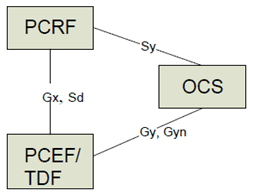Content for TS 23.203 Word version: 19.1.0
0…
4…
5…
6…
6.1.4…
6.1.7…
6.1.10…
6.1.17…
6.2…
6.2.2…
6.2.3…
6.3
6.4…
6.8…
7…
7.3…
7.4…
7.7…
7.7.3…
7.8…
A…
A.4…
D…
P…
P.4.2.4…
P.7…
P.7.5…
P.8
Q…
S…
S.7…
S.8.8
T…
Q How to achieve Usage Monitoring via the OCS
R Disabling/re-enabling Usage Monitoring for a PCC/ADC rule
...
...
Q How to achieve Usage Monitoring via the OCS |R12| p. 240
An alternative to providing the usage monitoring feature described in this technical specification is to re-use the capabilities defined in 3GPP Release 11 for implementation of Policy Control based on Subscriber Spending Limits when online charging is also performed.
There are two ways defined in this Annex to achieve usage monitoring via OCS:
If PCC/ADC rules that are subject to usage monitoring share the same charging key, the same measurement methods then the Usage Reports over Gy are used for both charging and usage monitoring and in addition:
- Policy Counter Status values are associated with the quota allocated with Charging Keys are configured in the OCS. Policy Counter Status (INQUOTA, OUTQUOTA) changes trigger notifications over Sy.
- The PCRF is configured with operator policies that associate the policy counter status to a policy decision e.g. block or allow a service to a QoS.
- A common Charging Key is used for all services that are subject to usage monitoring. The charging control information of the PCC/ADC rules includes that online charging applies, the common charging key for the service and service level reporting is activated. In addition, the measurement method is to be set to time/volume.
- Policy Counter Status values associated with the quota allocated with Service identifier is configured in the OCS. Policy Counter Status (INQUOTA, OUTQUOTA) changes trigger notifications over Sy.
- The PCRF is configured with operator policies that associate the policy counter status to a policy decision e.g. block or allow a service to a QoS.

Figure Q.1-1: Deployment for Usage Monitoring via Online Charging System
(⇒ copy of original 3GPP image)
(⇒ copy of original 3GPP image)
R Disabling/re-enabling Usage Monitoring for a PCC/ADC rule |R12| p. 241
If usage monitoring for a PCC/ADC rule (belonging to a usage monitoring group) needs to be disabled, one of the two ways below can be chosen to realize this feature:
- The PCRF generates a new PCC/ADC rule with the same information (apart from the PCC/ADC Rule identifier) as the existing PCC/ADC rule used to control the same traffic but without the monitoring key. The PCRF provides the new PCC/ADC rule to the PCEF/TDF and removes the existing PCC/ADC rule.
- The operator selects a specific monitoring key value to be used for all PCC/ADC rules for which usage monitoring is disabled. The PCRF modifies the monitoring key of the corresponding PCC/ADC rule to this specific value. Following the PCRF instruction, the PCEF or TDF updates the monitoring key in the modified PCC/ADC rule and collects the usage information for the specific monitoring key value. The PCEF/TDF usage reports would still be received by the PCRF but could be ignored.
- The PCRF generates a new PCC/ADC rule with the same information (apart from the PCC/ADC Rule identifier) as the existing PCC/ADC rule used to control the same traffic and adds the required monitoring key. The PCRF provides the new PCC/ADC rule to the PCEF/TDF and removes the existing PCC/ADC rule without monitoring key. The PCEF/TDF executes the operations in the same way it is described above in Note 1.
- The PCRF modifies the monitoring key of the corresponding PCC/ADC rule to the value of the required usage monitoring group (e.g. back to its original value).